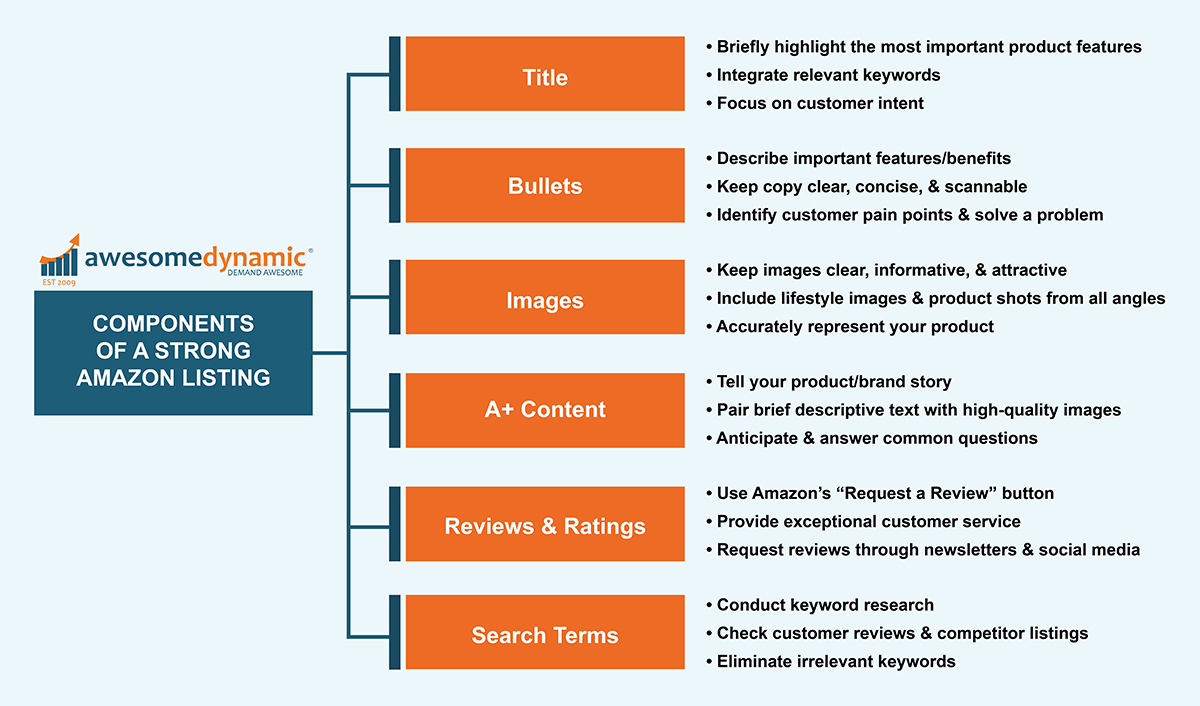June 29th, 2023
Amazon prominently holds the title as the world's largest online retailer and with that brings a vast catalog of merchandise and sellers. In 2019, Amazon had more than 2 million active sellers worldwide. Every year more than a million new sellers join Amazon, however, the average seller is unable to exceed $40,000 per year. One of the first things to focus on as an Amazon Seller is product optimization.
What is Amazon Product Listing Optimization?
Amazon listing optimization is the process of improving Amazon product pages to help improve organic rankings and sales. In order to effectively optimize your listing you’ll need to utilize relevant keywords, write strategic copy for the title, bullet points, and description, include high-quality product images, answer common customer questions, and increase the number of reviews on your product detail page.
The goals of focusing on Amazon product listing optimization are to improve your:
- Search relevancy or visibility
- Click-through rate (CTR)
- Conversion rate (CR)
How Do I Optimize an Amazon Listing?
Identify Relevant Keywords
Keywords drive your search results and visibility. A product that is buried in the search results will have lower click-through and conversion rates. Including relevant keywords will help you rank better and showcase your products to interested buyers.
With Amazon optimization, your first priority should be identifying the top-ranking keywords for your product. To get started, research your competition on Amazon, search Google, and invest in software to help generate keywords. Research is essential to identify keywords that help to describe the product correctly.
Collaborating with an experienced Amazon Account Management team can help you reach your target audience quickly and effectively. They will take care of keyword research and equip you with the necessary tools to optimize your product listings without adding additional tasks to your to-do list.
Once you have a list of keywords you’ll want to incorporate them in your product listing title, bullet points, and description. Be sure to include relevant keywords in your product title. The title of your product is crucial because its keywords inform Amazon's A9 algorithm about what your product is and how well it matches their search.
Once your title is complete, incorporate the next few high-ranking keywords into your bullet points and description. While it's important to create keyword-rich copy, avoid keyword stuffing. Your content should be clear, informative, conversational, and easy to read. Poorly written bullets and descriptions can reflect poorly on your brand and compromise your credibility with potential buyers.
Creating strong, visually striking Amazon A+ Content is a great way to stand out from your competitors and make your product listing shine. If you’re a brand-registered seller, creating well-crafted A+ Content can help add credibility to your brand and boost sales by up to 10%!
Utilize the most relevant keywords within your content as long as it enhances your content and helps them make an informed buying decision. Once your copy is complete, add additional keywords as part of your backend keywords. Adding backend keywords will also help your search results.
Write Informative Content
Have you heard the phrase ‘content is king’? This catchy saying is more than just cliche - it’s also accurate! Having quality content is essential for Amazon product optimization. Badly written or confusing content can cost you customers and sales.
Your Amazon product title is the initial impression a shopper has when they discover your listing. It’s also one of the most significant factors for Amazon's search engine, connecting your listing with the customer's search. When composing your title, include the most important and relevant keywords.
Next up are your bullet points. Begin with the most important details about your product. Amazon allows for five bullet points, but mobile users may only see the first three. Keep these bullets concise yet informative to provide a quick and easy overview of your product. This information is vital for boosting conversions since most customers won't read beyond them.
Potential buyers can scroll down to read your product description. It can be found under the images and bullet points. This section provides more details about your product, allowing you to use descriptive language to highlight its features and benefits. You can also use this space to connect with potential customers by using a conversational tone and enhancing your brand awareness.
In all three sections, start with keyword research. Add the most important keywords into your title, follow with your bullet points, and finally the description. Any keywords that do not fit seamlessly into your writing can be utilized in your backend keyword section. Do not sacrifice the quality of your writing to include additional keywords.
Share Eye-Catching Product Images
Shopping online has become a convenience many businesses and families depend on, however, there is one drawback - customers can’t actually hold your products and see how they work in real-time. Updating your product detail page with professional photography is the best way to overcome this obstacle and highlight your product to interested shoppers.
Within your product listing, you have the opportunity to add several images. Start with a standard product image with a white or plain background but be sure to consider the customer's standpoint. What matters most to them? Are they concerned about size and fit? Do they need to know about compatibility?
Include an image with dimensions to help explain the size visually. Think about utilizing infographics to showcase your image but also easily highlight product details and features. Share lifestyle photos to show the product in use and give shoppers an idea of how this product could be used in their everyday lives. Images are most effective when they answer common questions and give shoppers a real feel for your product.
It is important to focus on quality. Clear and crisp photos help to sell your product. Double-check to make sure your images and videos look professional and enhance your product detail page.

Gain Reviews and Answer Questions
Amazon prides itself on creating the ultimate shopper experience. They support this mission by providing authentic reviews and feedback, including a section where shoppers can ask questions before or after they buy. While these areas are often overlooked by sellers, they are highly important for your Amazon product optimization.
Getting quality reviews plays a significant role on product ranking. Having trouble getting the reviews you need to generate interest? If you have a new product on Amazon you can enroll in Amazon’s Vine program which helps listings with less than 30 reviews generate credible reviews.
The questions that customers ask on your product page can be answered by sellers, vendors, and other customers. As an Amazon seller, it’s important to keep an eye on these questions and provide prompt, courteous responses. This is a great way to communicate directly and develop a meaningful connection.
Keep in mind, there are best practices to follow when trying to get reviews for new products and established products. We’ve identified those in more detail here, How to Get Amazon Reviews - The Right Way.
FAQs
How does Amazon Product Listing Optimization impact sales?
Amazon optimization is one of the most effective ways to improve your search relevancy, click-through rate (CTR), and conversion rate (CR). Better content naturally leads to higher conversions and sales.
Can I use long-tail keywords in my product listings?
Using long-tail keywords can reduce competition, make it easier to rank organically, and improve conversions. Using these valuable keywords attracts shoppers that are more likely to make a purchase.
What is the ideal length for product titles on Amazon?
Typically, Amazon product titles should be between 150 and 200 characters. Be sure to check the requirements for your product category.
How can I encourage customers to leave reviews?
Providing a great customer experience, optimizing your product detail pages, and enrolling in Amazon Vine can help you develop an arsenal of reviews.
Following these steps will help get your Amazon listing optimized for increased success. If you are unsure about Amazon’s guidelines or find yourself staring at a blank screen when trying to write content, our team is here to help. Simply schedule your free 30-minute consultation to learn more.

